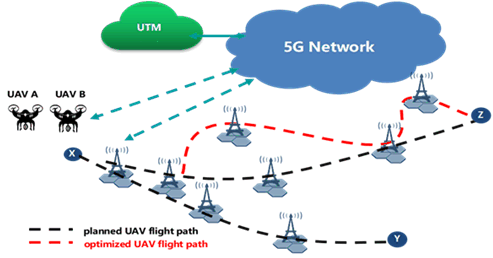Content for TR 22.843 Word version: 19.2.0
5.2 Use case on supporting UAV pre-flight preparation
5.2.1 Description
5.2.2 Pre-conditions
5.2.3 Service Flows
5.2.4 Post-conditions
5.2.5 Existing features partly or fully covering the use case functionality
5.2.6 Potential New Requirements needed to support the use case
...
...
5.2 Use case on supporting UAV pre-flight preparation p. 9
5.2.1 Description p. 9
During the operation of UAVs using the 3GPP network access, the network needs to ensure that the UAVs can access the network smoothly and timely. UAV flight mission need to be ensured for the real-time performance and stability of flight control link to guarantee the continuity of the flight.
5G network can provide wide-area, high-quality and secure connectivity that can enable cost-efficient UAV operations beyond visual line-of-sight (BVLOS) range. In some industrial UAV scenarios, the UAV would be provided pre-scheduled flight plan for autonomous flying. When UAV uses 3GPP network as the access type, the UTM/UAV operator may need to acknowledge the network status for flight path scheduling with the help of 3GPP network.5G system can assist the UTM and drone operator with providing alternative flight path based on the supported QoS in specific area or reconfigure network resources to achieve the needed QoS.
5.2.2 Pre-conditions p. 9
Pipeline company uses UAV A and logistics company uses UAV B. UAV A and UAV B are both individual terminals that subscribe to the communication service from 5G network.
Operator A provides 5G network coverage and communication services for remote command and control (C2) communication between UAV and UAV control platform.
The UTM has good cooperation with Operator A to have UAV-related information which is fetched from the 5G network.
5.2.3 Service Flows p. 10

- The pipeline company plans to use UAV A to provide video inspection of pipelines from X to Y and the logistics company uses UAV B to deliver express from X to Z.
- UAV/UAV-C A and UAV/UAV-C B register in 5G network and can communicate with UTM though 5G network.
- The UAV-C A provides planned flight path information from X to Y to UTM (e.g. waypoints and required QoS from X to Y). The UAV-C B provides planned flight path on start point X, end point Z and needed QoS.
- UTM checks with 5G system for required and needed QoS information in predictions/statistics (e.g. end-to-end latency, QoE) along required and possible flight paths.
- Based on the available analytics information, the 5G system can provide confirmation that required QoS is available for UAV A flight path or alternatively can reconfigure network resources to be able to provide the required QoS to UAV A along the flight path. As UAV B can take alternative routes, 5G system can provide optimized flight path considering where the QoS is available.
- UTM/UAS determines the final flight paths based on the information from Operator A and sends to UAV/UAV-C A and UAV/UAV-C B separately.
- UAV A and UAV B receive the flight path information from UTM/UAS via the 5G system and start flight mission.
5.2.4 Post-conditions p. 10
UAV A and UAV B can finish their respective tasks with the support of 5G system.
5.2.5 Existing features partly or fully covering the use case functionality p. 10
None.
5.2.6 Potential New Requirements needed to support the use case p. 10
[P.R 5.2.6-001]
Based on operator's policy, the 5G system shall be able to support a method to predict network conditions and QoS (e.g. bitrate, latency, reliability) along a continuous geographic planned flight path of a UAV at specific times of its expected flight duration.
[P.R 5.2.6-002]
Based on operator's policy, the 5G system shall be able to provide UTM with the information about geographic areas where UAV service requirements could or could not be met based on predicted network conditions and QoS (e.g. bitrate, latency, reliability).
[P.R 5.2.6-003]
Based on 3rd party request, the 5G system shall be able to provide to the 3rd party alternative UAV flight paths, as long as UTM-provided required waypoints (e.g. start/end locations), required QoS, and exclusion zones are fulfilled.
[P.R 5.2.6-004]
Based on 3rd party request and operator's policy, the 5G system shall be able to reconfigure network resources to provide the required QoS along a UAV planned flight path, e.g. at particular geographical area(s) and time(s).